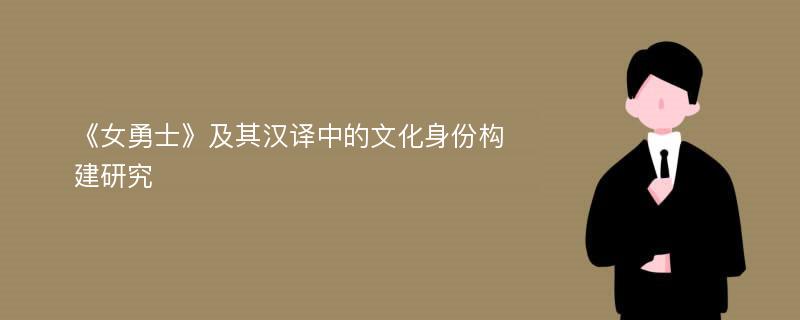
论文摘要
作为美国文学,特别是亚裔美国文学不可或缺的一个分支,华裔美国文学自二十世纪六十年代以来,已经经历了从被消音到被广泛讨论,从被曾一度边缘化到逐渐进入美国主流社会的错综复杂的历程。汤亭亭及她的处女作《女勇士》则被公认为最具里程碑意义的代表作之一。该作也因备受争议的写作手法以及对中国文化元素的灵活应用成为学术界讨论的焦点,且大多侧重女性主义、后殖民主义、后现代主义及文化研究等多方面的研究。尽管文化身份认同是其研究的重要话题,但从翻译角度来审视汤亭亭在《女勇士》中的文化身份构建则鲜有学者涉及。此外,较《女勇士》在欧美社会备受追捧并被广泛阅读的事实,这一与中国文化有着紧密联系的华裔美国文学作品中国人却知之甚少,相关讨论也有所局限。这在很大程度上与其在中国的译介有很大关系。因此本文旨在研究汤亭亭《女勇士》及其汉译本中的文化身份构建。本文以《女勇士》为研究对象,在将汤亭亭的跨文化书写定义为广义上的文化翻译的基础上,以后殖民翻译理论为主线,分别探讨两次翻译行为,即汤亭亭的文化翻译和《女勇士》的汉译中文化身份的构建。在对汤亭亭全面客观分析和对中国译者在翻译此作品时面临的困境与出现的问题进行深入探讨的基础上,在文化全球化日益频繁的背景下,本文提出《女勇士》乃至整个华裔美国文学汉译时应采取的适宜的翻译策略。定性分析、描写与对比等方法是本文基本的研究方法。本文通过分析发现,汤亭亭及其他许多华裔美国作家的文化翻译是其特殊的经历及历史使然,通过翻译中国文化元素他们在有意或无意中参与并完成了其自身以及整个美国华裔的文化身份构建。通过异化甚至杂合中美文化的方式,汤亭亭不仅再现了一个弱势的“中国”文化形象,构建了美国主流文化的强势身份,同时也构建了一个新的寄居在美国本土的华裔美国族裔的文化身份。另一方面,由于政治、意识形态及个人因素,《女勇士》的汉译者同大多数华裔美国文学的中国译者一样,通过归化、省略及增译等翻译手段再现的是一个强势的美国文化而不是华裔美国文化,塑造了被美国文化和华裔美国文化俯视的相对弱势的中国本土文化形象,而自身译者的文化身份也未能充分体现。本文最后发现翻译伦理尤其是差异伦理可为《女勇士》乃至整个华裔美国文学的汉译找到出路,即中国译者应该恰当的使用归化、异化及二者杂合的翻译策略来调节原作中的不同文化,保留原作者有意为之的差异,以期完成文化全球化背景下中国文化、美国文化以及华裔美国文化之间的跨文化交流。本文在对《女勇士》的研究提供更新,全面以及客观的研究视角方面具有重要意义,同时也为整个华裔美国文学的汉译研究做出一定贡献。
论文目录
AcknowledgementsAbstract摘要IntroductionChapter 1 An Overview of The Woman Warrior1.1 A Brief Introduction to Chinese American Literature and Diasporic Background1.2 An Brief Survey of The Woman Warrior and Its Translation in China1.3 Study of The Woman Warrior at Home and Abroad1.3.1 Study of The Woman Warrior in America1.3.2 Study of The Woman Warrior in ChinaChapter Ⅱ Translation as the Construction of Cultural Identity in Post-colonial Context2.1 Post-colonial Turn in Translation Studies2.3 Cultural Identity2.3.1 The Definition of Cultural Identity2.3.2 The Formation of Cultural Identity2.4 Construction of Cultural Identity and Translation in Post-colonial Context2.4.1 The Representation of Foreign Cultures2.4.2 The Creation of Domestic Subjects2.4.3 The Formation of Target Culture2.5 SummaryChapter Ⅲ Construction of Cultural Identity in The Woman Warrior3.1 Cultural Translation as A Writing Technique3.2 Motives and Necessities for Kingston’s Cultural Translation3.2.1 Diaspora and Cross-boarder3.2.2 Westerners’Appeal for Stereotype3.2.3 Cultural Translatability3.3 Construction of Cultural Identity through Kingston’s Cultural Translation3.3.1 Hybridity as the Proper Translation Strategy3.3.2 Representation of “Chinese”Culture3.3.3 Constructing Dominant American Culture3.3.4 Formation of Domestic Subject: A New Image of Chinese Americans3.4 SummaryChapter Ⅳ Construction of Cultural Identity through E-C Translation of The Woman Warrior4.1 The Dilemma Chinese Translators May Face4.2 Factors Influencing E-C Translation of The Woman Warrior4.2.1 Asymmetrical Power Relations4.2.2 Domestic Ideology, Poetics and Patronage4.2.3 Translator’s Personal Ideology and Cultural Background4.3 Problems Existing in E-C Translation of The Woman Warrior4.3.1 Domestication4.3.2 Omission4.3.3 Mistranslation4.3.4 Amplification4.4 Construction of Cultural Identity through E-C Translation of The Woman Warri4.4.1 Representation of “American”Culture4.4.2 Construction of Chinese Culture4.4.3 Constructing the Cultural identity of Chinese TranslatorsChapter Ⅴ Translating Ethics Concerning E-C Translation of The Woman Warrior under Cultural Globalization5.1 Cultural Globalization and Localization5.2 Translation Ethics and Cultural Globalization5.2.1 The Implication of Translation Ethics5.2.2 Ethics of Difference under Cultural Globalization5.3 Chinese Translator’s Ethical Choice of E-C Translation of The Woman Warrior5.3.1 Preserving Difference5.3.2 Representing Domestic Cultural Identity of Chinese Americans5.3.3 Mediating Different CulturesConclusion6.1 Major Findings6.2 LimitationsBibliographyAppendix (A)Appendix (B)
相关论文文献
- [1].论汤亭亭《女勇士》对美国东方主义的颠覆与超越[J]. 长春师范大学学报 2017(05)
- [2].《女勇士》中的汉文化书写[J]. 文教资料 2017(17)
- [3].《女勇士》中的边缘化母亲——中国的“陌生人”和“边缘人[J]. 明日风尚 2017(02)
- [4].《女勇士》中“疯女人”的母题研究[J]. 北方文学 2017(23)
- [5].从女性主义视角浅析汤亭亭《女勇士》[J]. 校园英语 2017(30)
- [6].翻译伦理视域下的《女勇士》汉译[J]. 文教资料 2020(27)
- [7].《女勇士》中的创伤与复原——基于创伤理论的解读[J]. 海外英语 2017(18)
- [8].生命创痛与存在之勇——《女勇士》解读[J]. 昭通学院学报 2015(01)
- [9].小说《女勇士》的文学解读[J]. 短篇小说(原创版) 2016(08)
- [10].《女勇士》中的花木兰形象解析[J]. 校园英语 2015(15)
- [11].浅析《女勇士》中的女性形象[J]. 长城 2012(02)
- [12].华裔作品《女勇士》的中国文化评析[J]. 芒种 2012(24)
- [13].汤亭亭“他者”视角下的文化误解——以《女勇士》为例[J]. 作家 2010(24)
- [14].《女勇士》的解构主义解读[J]. 文化学刊 2020(05)
- [15].《女勇士》中的“错误书写”[J]. 淮海工学院学报(人文社会科学版) 2018(08)
- [16].《女勇士》的“孤独”主题分析[J]. 常州工学院学报(社科版) 2018(05)
- [17].《女勇士》主要角色宗教观念的冲突与融合[J]. 湖北工业大学学报 2015(06)
- [18].《女勇士》开篇《无名女人》中的女性探索主题[J]. 北方文学 2020(14)
- [19].原型意象的文化意蕴——《女勇士》的神话原型解读[J]. 作家 2012(18)
- [20].“中国形象”:《女勇士》中的“他者”[J]. 作家 2011(08)
- [21].《女勇士》汉译中的文化身份构建[J]. 天水师范学院学报 2014(02)
- [22].讲故事的人:《女勇士》中的母亲形象解读[J]. 大众文艺 2014(16)
- [23].《女勇士》中语言力量的体现[J]. 大众文艺 2011(17)
- [24].《女勇士》中的英雄观探析[J]. 常州工学院学报(社科版) 2019(04)
- [25].论汤婷婷《女勇士》的女性哥特式特征[J]. 忻州师范学院学报 2018(03)
- [26].浅议汤亭亭《女勇士》中的创伤叙事[J]. 出版广角 2015(13)
- [27].“岳母刺字”典故在《女勇士》中的“移位”探究[J]. 钦州学院学报 2016(02)
- [28].从《女勇士》看汤亭亭的文化视角[J]. 长沙大学学报 2016(03)
- [29].《女勇士》中的女性主体意识和文化冲突探究[J]. 雪莲 2015(21)
- [30].生态女性主义视角下的《女勇士》[J]. 作家 2012(08)
标签:女勇士论文; 流散论文; 文化身份论文; 翻译论文; 差异论文;

